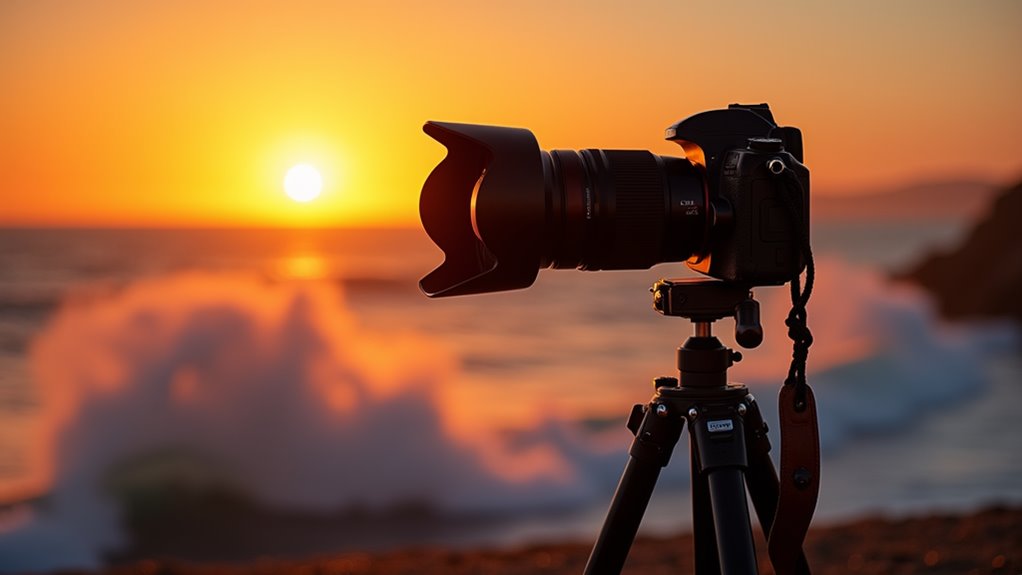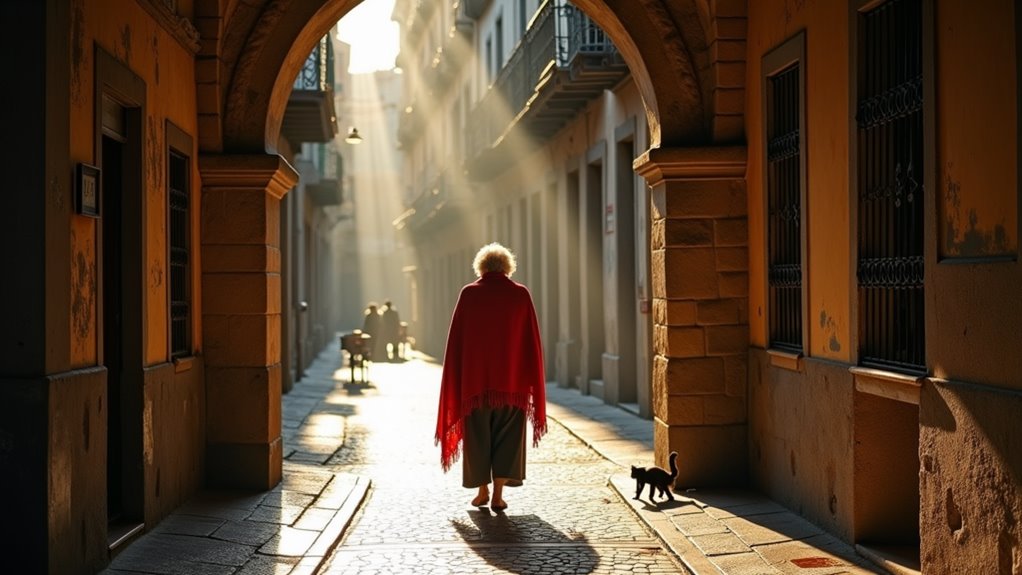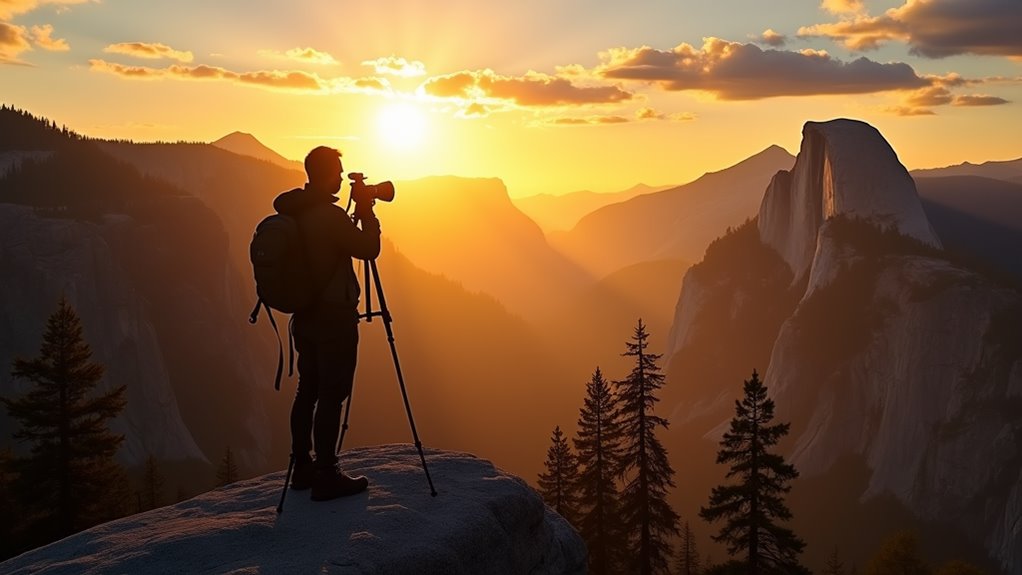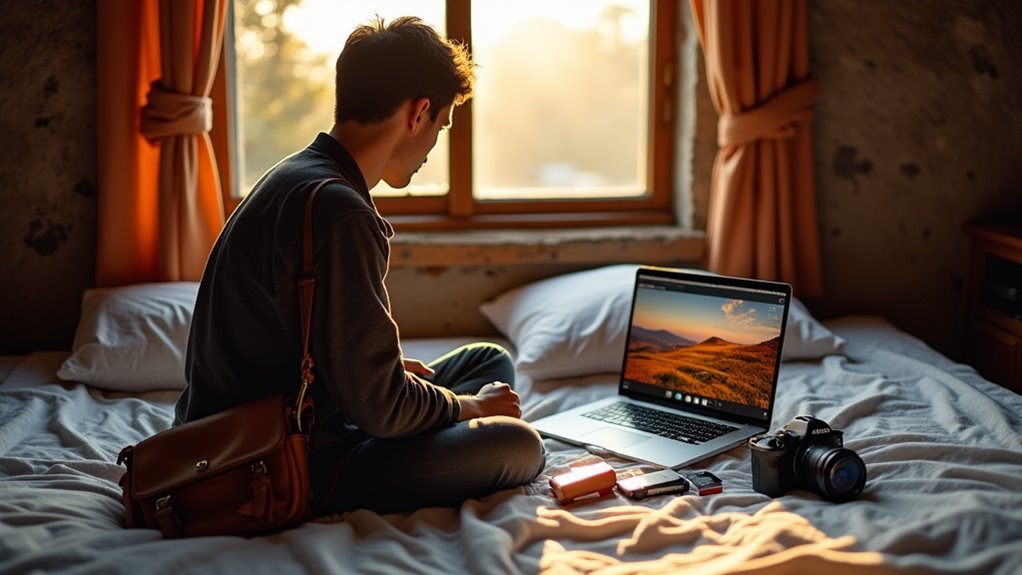To capture compelling travel memories through photography, you'll need a versatile camera setup and a keen eye for authentic moments. Start with essential gear: a reliable camera body, two versatile lenses, and a lightweight tripod. Take advantage of golden hour lighting during sunrise and sunset, while adapting your technique for challenging midday conditions. Focus on candid shots that tell genuine stories, and always respect local customs when photographing people. Don't forget to protect your precious memories with a solid backup strategy using multiple storage options. The art of travel photography combines technical skills and cultural sensitivity to create lasting visual stories that transport you back to each moment.
Key Takeaways
- Pack versatile camera gear including a reliable body, essential lenses, and protective equipment to ensure readiness for diverse shooting scenarios.
- Maximize photo opportunities during golden hours and learn to adapt shooting techniques for different lighting conditions throughout the day.
- Practice authentic travel photography by capturing candid moments and respecting local customs while building genuine connections with subjects.
- Implement a robust backup strategy using multiple memory cards and hard drives to protect precious travel memories.
- Master basic editing techniques to enhance photos while maintaining authenticity, using mobile apps for quick adjustments on the go.
Essential Camera Gear for Travelers

While you can capture memorable travel moments with just a smartphone, having the right camera gear elevates your photography to the next level.
Start with a versatile mirrorless or DSLR camera body and two essential lenses: a wide-angle zoom for landscapes and architecture, and a standard zoom for everyday shots.
Pack a lightweight tripod for low-light situations and long exposures.
Don't forget spare batteries, memory cards, and a cleaning kit to keep your equipment in top shape.
A weather-resistant camera bag will protect your gear while providing easy access during shoots.
If you're heading to remote locations, consider bringing a portable power bank and storage device to back up your photos.
For underwater adventures, invest in a quality waterproof housing or action camera.
Mastering Natural Light
Since natural light can make or break a travel photo, understanding how to work with it's crucial for capturing stunning images.
You'll find the best lighting conditions during the "golden hours" – the first hour after sunrise and the last hour before sunset, when the sun casts warm, gentle hues across landscapes and softens harsh shadows.
During midday, when the sun is directly overhead, you'll need to adapt your shooting style. Look for shaded areas to photograph people, or use the intense light to capture high-contrast architectural shots.
If you're shooting in overcast conditions, you can take advantage of the soft, diffused light for portraits and detailed shots of cultural objects.
Remember to position yourself with the sun at your back or side angle for optimal illumination, and always monitor your camera's exposure settings.
Street Photography Tips

Street photography captures the vibrant pulse of a destination through candid moments and genuine human interactions. You'll want to blend into the scene while staying alert to developing situations around you. Keep your camera ready and pre-set for quick shots.
Position yourself in high-traffic areas where interesting encounters are likely to unfold. Markets, busy intersections, and popular gathering spots often yield compelling imagery.
When photographing people, respect local customs and personal boundaries. If someone objects to being photographed, graciously move on.
Try shooting from the hip to remain discreet, and use a wider lens to capture more context. Focus on authentic moments: vendors arranging their stalls, children playing, or elderly couples strolling.
These unscripted scenes tell the most powerful stories of daily life in your destination.
Framing Cultural Moments
Beyond spontaneous street scenes, cultural moments offer rich opportunities for meaningful travel photography. You'll find these moments in festivals, ceremonies, traditional markets, and daily rituals that define local life.
When photographing cultural events, position yourself where you can capture both the main action and people's reactions. Respect local customs by asking permission when appropriate and keeping a considerate distance during sacred ceremonies.
Watch for small details that tell bigger stories – hands preparing traditional food, artisans at work, or elders passing down customs to younger generations.
Pay attention to lighting, as many cultural events happen at dawn, dusk, or in dimly lit spaces. Focus on genuine interactions rather than staged poses to convey authentic cultural experiences through your lens.
Landscape Photography on the Move

While traveling between destinations, you'll encounter countless opportunities to capture breathtaking landscapes. Whether you're on a train, bus, or in a car, you can snap stunning photos through windows or during brief stops. Keep your camera ready with pre-adjusted settings for quick shots, as timing is crucial when you're in motion.
Look for leading lines in roads, railways, or natural formations to create depth in your compositions. Pay attention to the quality of light during golden hours, and don't let cloudy weather discourage you – overcast skies can add drama to your landscape shots.
When shooting through vehicle windows, position your lens close to the glass to minimize reflections, and increase your shutter speed to combat motion blur.
Portrait Stories From Around World
When you take portraits during your travels, you'll create intimate connections that transcend language barriers and cultural differences.
You can start by learning essential street photography techniques like reading body language, maintaining respectful distances, and mastering quick camera settings for spontaneous moments.
Through your lens, you'll capture the authentic stories of local characters, from weathered fishermen mending nets to vibrant market vendors sharing their daily rituals.
Face-to-Face Cultural Connections
How do you capture the true essence of global travel? It's found in the faces of those you'll meet along your journey.
When you're photographing people from different cultures, you'll discover stories that transcend language barriers.
You'll need to approach portrait photography with respect and genuine curiosity. Ask permission before taking photos, and take time to interact with your subjects.
Learn to read body language and facial expressions that signal comfort or discomfort. When you're shooting, focus on capturing authentic moments rather than posed shots.
Remember that every wrinkle, smile, and glance tells a story about the local way of life.
Through your lens, you're not just documenting appearances – you're preserving the human connections that make travel meaningful.
Street Portrait Photography Tips
Confidence plays a vital role in capturing compelling street portraits around the world. When approaching potential subjects, maintain open body language and a genuine smile while respecting local customs and personal boundaries.
Before raising your camera, establish a connection through basic greetings in the local language. You'll find most people respond positively when you show genuine interest in their lives and culture. If someone declines, thank them and move on gracefully.
Choose your camera settings in advance – fast shutter speeds and wide apertures work well for street portraits. Frame your subject thoughtfully, considering the background and available light.
Keep interactions brief but meaningful, and always offer to share the photos or show them on your camera's display. When possible, gather their story to add context to your images.
Storytelling Through Local Characters
Every portrait tells a unique story about humanity's shared experiences across cultures. When you photograph local characters during your travels, you're not just capturing faces – you're documenting lifetimes of wisdom, tradition, and personal history.
Start by building genuine connections with your subjects. Learn a few basic phrases in their language, share a smile, and take time to understand their daily routines. Let them guide you through their world before raising your camera.
When you're ready to shoot, focus on candid moments that reveal their personality: a vendor arranging produce at dawn, an elder teaching crafts to children, or an artisan perfecting generations-old techniques.
Include environmental elements that provide context to their story, whether it's their workplace, home, or community gathering space.
Editing While on the Road

When you're on the road capturing memories, you'll need a solid system for managing your digital files, backing up photos, and maintaining efficient editing workflows.
You can streamline your post-processing by organizing photos into dated folders and using preset templates for quick adjustments to exposure, contrast, and color.
Keep your work safe by regularly backing up to portable hard drives or cloud storage services when you find reliable internet connections.
Organizing Digital Storage Space
Since digital storage management can make or break a travel photography trip, you'll need a reliable system for backing up and organizing your images on the road.
Start by bringing multiple high-capacity memory cards and at least two portable hard drives for redundancy.
Create a logical folder structure organized by date and location, and back up your photos daily to both drives.
Don't forget to keep one drive separate from your camera gear in case of theft or loss.
Cloud storage can serve as an additional backup when you have reliable internet access, though you'll want to compress your files first to save bandwidth.
Clear your memory cards only after you've confirmed that your images are safely stored in multiple locations.
Consider using a laptop with photo management software to help streamline your organization process.
Quick Post-Processing Tips
Although time on the road can be limited, basic photo editing helps ensure your travel images stay captivating and share-worthy. Start by adjusting exposure and contrast to make your photos pop, then fine-tune the white balance to correct any color casts from artificial lighting or weather conditions.
You'll want to crop your images to improve composition and remove distracting elements. If you're working on a mobile device, apps like Snapseed or VSCO offer powerful tools for quick adjustments.
Focus on essential edits: boost shadows to reveal hidden details, reduce highlights to preserve sky details, and add subtle vibrance to enhance colors naturally.
Don't overprocess your photos – aim to maintain their authentic feel while making them more visually appealing. Save your edited images in high resolution for future use.
Backup Solutions While Traveling
Three essential backup strategies can protect your precious travel photos from loss or corruption while you're on the road.
First, carry multiple memory cards rather than relying on a single large-capacity card. If one fails, you'll still have others.
Second, back up your images to a portable external hard drive each evening. Choose a rugged model that can withstand the rigors of travel.
Finally, whenever possible, upload your most important shots to a cloud storage service like Google Drive or Dropbox. If your internet connection is slow, select only your favorite images to upload.
This three-tiered approach ensures you won't lose your photographs to theft, damage, or technical failures during your journey.
Frequently Asked Questions
How Do You Protect Camera Equipment in Extreme Weather Conditions?
You'll need waterproof camera bags or rain covers to shield your equipment from moisture and dust.
Keep silica gel packets in your camera bag to absorb humidity, and let your gear gradually adjust to temperature changes to prevent condensation.
Use UV filters to protect lenses, and always carry microfiber cloths to wipe away water droplets.
In extreme cold, keep spare batteries warm in your pockets.
What's the Best Way to Photograph at Night Without Using Flash?
You'll need to master three key settings for great night photos without flash: use a slow shutter speed (try 10-30 seconds), open your aperture wide (lowest f-number), and increase your ISO (start at 800-1600).
Mount your camera on a tripod to prevent shake, and try shooting in RAW format.
Look for existing light sources like street lamps or moonlight to add natural illumination to your composition.
Should I Ask Permission Before Photographing Strangers in Foreign Countries?
Yes, you should always ask for permission before photographing strangers, regardless of the country you're in.
It's both a matter of respect and safety. While some cultures are more open to being photographed than others, getting consent helps avoid misunderstandings and potential conflicts.
You can use gestures or learn basic phrases in the local language to ask politely. If someone refuses, respect their decision and move on.
How Can I Back up Photos When Traveling Without a Laptop?
You've got several reliable options to back up your photos while traveling light.
Upload images to cloud services like Google Photos or iCloud when you have Wi-Fi access.
Bring multiple SD cards and rotate them daily.
Consider portable hard drives that connect directly to your phone, or use a tablet with USB connectivity.
Don't forget to pack a power bank to keep your devices charged during backup sessions.
What Insurance Coverage Do I Need for My Camera Gear Abroad?
When your $5,000 camera setup takes an unexpected swim in Venice's canals, you'll wish you'd gotten proper insurance!
You'll need two main types of coverage: personal articles or specialized photography insurance for theft/damage, and travel insurance that specifically covers expensive gear.
Don't rely on your standard homeowner's policy – they often have limited coverage abroad. Make sure your policy includes international coverage and replacement cost value.
Conclusion
You've got the tools to capture your journey like a modern-day Ansel Adams with an Instagram account. Don't let your travel photos become forgotten files on your hard drive – they're windows into the world you've experienced. Share your unique perspective, tell visual stories, and keep honing your craft. Whether you're shooting with a DSLR or your smartphone, remember: the best camera is the one you've got with you.

Leave a Reply